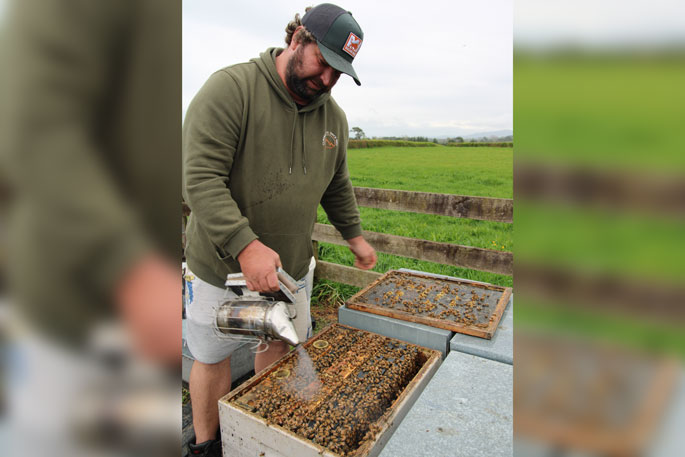A Waikato beekeeper has come full circle in what has becoming an increasingly unpredictable business.
Matt Crawford says limited returns for honey means the bulk of his income is being generated once again from pollination.
Based at Okauia, near Matamata, Matt and his wife Maxine run Golden Flow Apiaries which has about 1600 hives now chiefly pollinating kiwifruit orchards in the Western Bay of Plenty rather than producing honey in the Waikato.
He has been involved in the bee business for 17 years, starting out working for Golden Flow’s original owner Bryce Hooton.
Matt progressively bought a greater shareholding in the Okauia operation and took over full ownership seven years ago.
He said beekeeping was booming at that time, with Golden Flow Apiaries growing from 1400 to 2500 hives at its peak.
Pollination was a major part of the business originally, but Matt says this “took a toll” on the hives and a move was made to producing manuka honey.
But, with returns falling amidst an ongoing honey glut across the country, he has gone back to pollination which now makes up more than 70 per cent of the company’s income.
“Five years ago, we were a hundred per cent honey."
He said it's simply a question of cashflow.
Happy Balance
“We had to find a happy balance, or we would’ve been out of business two years ago.”
Like many of his fellow beekeepers around the country, Matt has just been selling surplus honey “sitting in the shed” for the last 3-4 years.
He said there has been a national over-supply, particularly of manuka honey, which has exceeded market demand over the past five years.
A 300kg drum of manuka honey which once fetched $120 would now return just $20 “if you’re lucky”.
Crawford said demand has increased for “table honey”, which fetches $7/kg compared to $3/kg three years ago.
However, he said most beekeepers in the honey trade were seeing their costs rise while their incomes have “gone backwards”.
Crawford knows of several who have simply “shut up shop” altogether.
“The hobbyists are gone. The whole industry has changed. You have to adapt to survive.”
Crawford believed though that the honey trade is “on the up” and getting back to similar levels to when he first started.
“We are just making a living,” he sayid “It’s more a lifestyle.
Golden Flow Apiaries has three fulltime employees, plus Craford’s wife Maxine and his father Maurice on a part-time basis.
The operation, on .5ha at Okauia, has an extracting plant to help with honey harvesting.
Full frames are collected from hives and 24 at a time are put through a spinner which separates honey from beeswax.
The honey is then filtered and put into vats, prior to going into sealed drums ready for trucking to Hamilton-based Honey New Zealand.
Safe Storage
Crawford said honey for the table is best stored in a cool, dark cupboard or pantry.
Beeswax can be used to make products including candles and lip balm.
Registered hive numbers in New Zealand have reportedly fallen from a high of 918,000 in 2019 to 601,000 at last report. North Island numbers have gone from 694,000 to 418,000 in that time.
Matt sids the existing stockpile of honey, coupled with increased competition in global markets, has however, continued to create challenges for processing companies.
Te Puke-based Comvita recently reported a full year loss of $77.4 million, citing a downturn in sales to China and North America.

Kiwifruit orchards
On the other side of the equation, Crawford said kiwifruit orchards are on the increase and with their reliance on bees to produce a crop, Bay of Plenty growers are having to go further and further afield to find hives.
He knew of some beekeepers even making the trip down from Northland to the Bay of Plenty last season to help meet demand.
Kiwifruit orchards have reportedly increased 12.5 per cent from 12,905 producing hectares in 2019/20 to 14,512ha in 2022/23.
Crawford said this means 1607ha of new orchards that require beehives, at an average of 10-12 hives per ha. Bay of Plenty is home to by far the largest area of kiwifruit orchards, with 11,429ha.
The pollination schedule sees Crawford drop off hives at orchards in late October.
There are 8-10 hives per canopy hectare, with his bees serving both the Gold and Green varieties of kiwifruit.
Crawford said hives, which return between $190 and $250 each, are usually left at the orchards for a couple of weeks before collection.
Kiwifruit is particularly reliant on insect pollinators as its male and female flowers are located on separate plants, he said.
During spring, when the flowers begin to open, Crawford said the bees and orchard managers were working hard to ensure a successful pollination in the orchards.



0 comments
Leave a Comment
You must be logged in to make a comment.